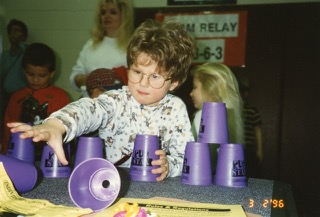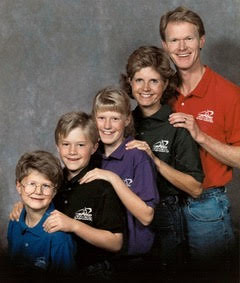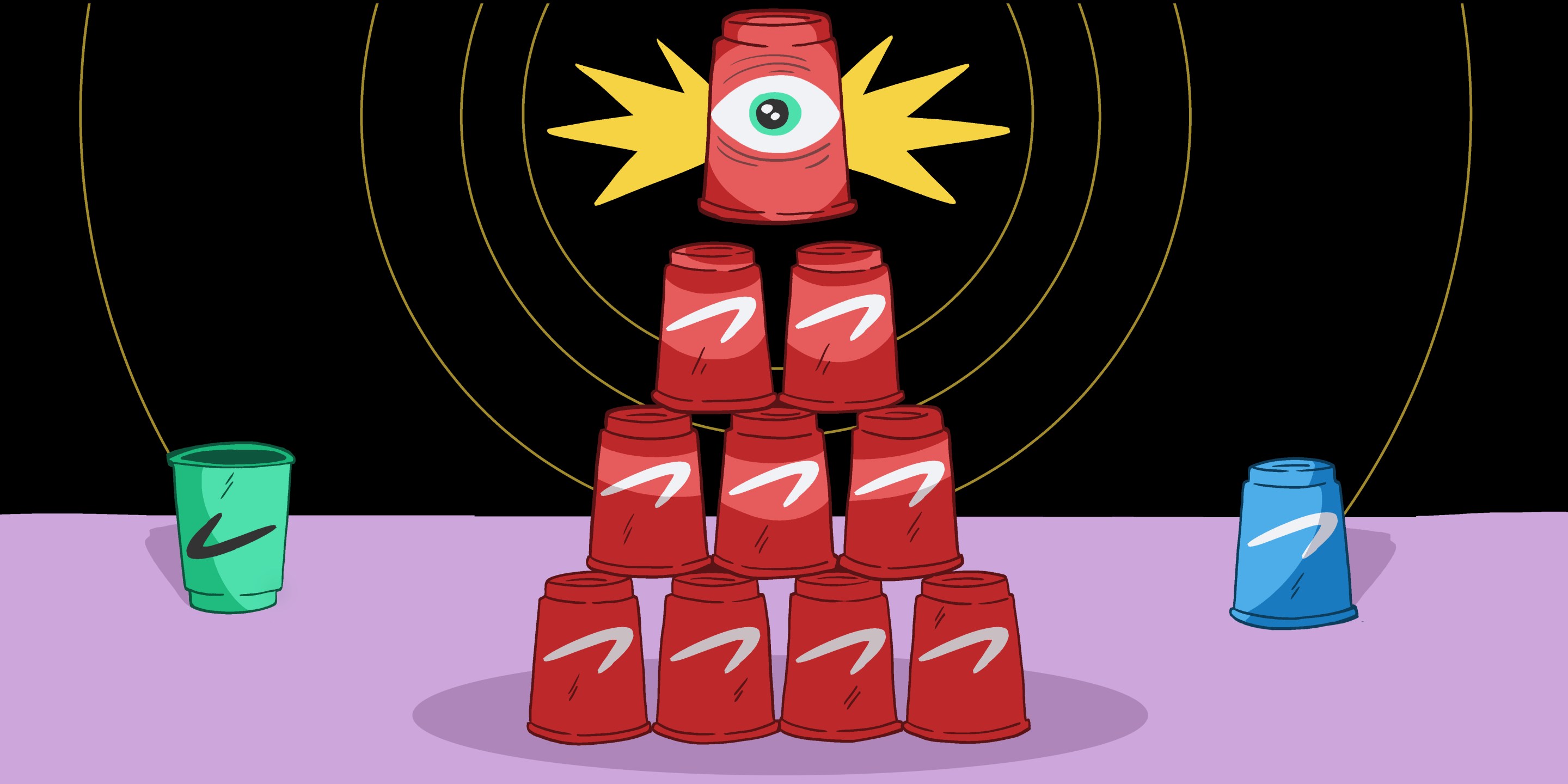The boxes came from Tokyo: first by tanker, then overland via container truck from a Pacific port, across the Continental Divide, and finally backed into a driveway at the end of a cul-de-sac in a south Denver suburban enclave. This was a neighborhood with Razor scooters dumped in trimmed front lawns. Where family walks with leashed dogs happened down the middle of intentionally curved streets named after long demolished natural landmarks like "Timbercrest" and "Forest Trails." Where the HOA (because of course there was an HOA) banned the installation of driveway basketball hoops.
Receiving industrial freight deliveries, freshly cleared through international customs, probably wasn't explicitly prohibited in the homeowner's handbook. But then, why would it need to be? Nobody would think to bring that kind of commercial chaos into the burgeoning middle-class peace of Castle Pines North in 1998.
If neighbors peeking behind curtains at the idling 18-wheeler thought to call in a complaint, the husband and wife receiving the delivery didn't notice. They were too busy unloading boxes—more than 800 of them.
Balancing four at a time on a handcart, it took 200 trips through the open garage door and down the unfinished basement steps. The boxes, holding smaller rectangular packages inscribed with Japanese lettering, were piled to the ceiling. There was enough room left for a skinny aisle leading back up the stairs, and two plastic tables ladened with tape and flat-rate USPS packaging.
5,800 miles away, a man in middle management at the global toy conglomerate Hasbro must have been very pleased. The delivery represented a small yet unexpected boon.
Those boxes were dead inventory, wasting space in a nondescript warehouse. They should have been headed for a landfill and a tax write-off. Instead, a Mr. Toshio Takiguchi brokered the export at a ¥1,300 per-unit cost. Not a tidy profit, but no longer a loss on the annual P&L. The remains of a failed business decision disappeared across the ocean. It was a certain Mr. Fox's problem now.
That problem cost $43,000, a sum that represented the entire life savings of Mr. Fox and his wife, who at that point had been surviving on public-school salaries. Friends and family never really said it out loud, but they were certainly thinking it: This was insane. What about the three kids and that mortgage?
The couple, though, never had a doubt.
"He always used to tell me, 'If I had 10,000 of these, I could sell them in a year,'" Mrs. Fox recalled, 27 years later.
That's the unabashed confidence you'd expect from any good entrepreneur, especially with the benefit of hindsight. But ask yourself this: Would you, watching this couple unload box after box into their bank-financed home, have bet on this man and his family's future if you knew exactly what he needed to sell?
Tucked inside those boxes, in nested columns of 12, were 120,000 plastic cups. They were turned upside down, each with a hole drilled through the middle of the base, rendering them useless in terms of a cup's normal, and really only, task.
The couple's future hinged on accomplishing what the world's second largest toy company could not: convincing thousands of kids that stacking these plastic cups in pre-determined patterns was … fun. More critically, the couple needed to convince the parents of those kids to actually buy these cups, despite not even being able to drink from them.
Mr. Takiguchi could breathe a sigh of relief. Mr. and Mrs. Fox had to get to work.

The first thing you need to know about Bob Fox is that he used to be a clown ... The second thing you need to know about my dad is that he was a really, really good clown.
Every few months, in different corners of the internet, someone asks a version of the same question: Why did we all stack plastic cups in elementary school PE class?
You'll see it multiple times in the Reddit community r/Zillenials, or infrequently posted as a random musing on Twitter and Facebook. In 2023, it was examined in a 25-minute YouTube video with 200,000 views titled, "What happened to this strange early 2000s craze?"
You might have even asked it yourself, perhaps after a few beers when a friend turned some Solo Cups upside down, activating one of your mid-aughts memories of sitting cross-legged on a linoleum gym floor, surrounded by the clatter of your classmates piling cups into pyramids.
Sport Stacking, as it's officially known (cup stacking and speed stacking as it is colloquially known), exists in the same cloud of millennial nostalgia where you'll find vague recollections of SlamBall and JoJo. It has appeared on pretty much every morning and late show, been a trend piece in both the New York Times and Wall Street Journal, and was once labeled by Glenn Beck as "what’s really wrong with America."
It has been a minor plot line in Fred Claus, Matt LeBlanc's Episodes, and Weeds; it's been the major plot line in a 2022 Thai-language film released on Netflix titled Fast & Feel Love (100 percent on Rotten Tomatoes). The infamous "Oh my gosh!" scream in Skrillex's "Scary Monsters and Nice Sprites" was sampled from a viral sport stacking video from 2008.
At its peak, between 2002 and 2011, roughly 5,000 American schools included it as part of their annual curriculum, according to Mr. and Mrs. Fox. That means somewhere between five and eight percent of U.S. adults between the ages of 22 and 35 share the same core memory—and in the ensuing years have asked themselves, their friends, or social media the same question: Why did credentialed educational professionals make us do this ludicrous activity in gym class?
I am, perhaps, the person best suited on the planet to answer this question. Because the answer … is my dad.
The first thing you need to know about Bob Fox is that he used to be a clown. Not in the figurative, funnyman personality sense. In the literal red-nose, black-eyeliner, juggling-tennis-balls-at-children’s-birthday-parties sense.
The second thing you need to know about my dad is that he was a really, really good clown.
He'd scoff at the mental image you probably have of him right now: oversized shoes, cartoonish honks, and bumbling choreography. My dad's act was entirely silent, required immense skill, and was predicated on audience participation. He was equally good at riding a unicycle and convincing the most curmudgeonly dad in the room to leave their back corner and join him onstage to try—and always fail—at blowing up a balloon animal. Kids went bananas. Adults always laughed.
The San Francisco 49ers hired him to be the walk-around entertainment for their post–Super Bowl ring ceremony in 1995. We used to shut the shades so neighbors didn't think he robbed a bank as he counted the cash he earned during Denver's largest busking festival.
This was a man who took the unserious very, very seriously.
As a high school theater teacher, he'd spend 60–80 hours a week building out increasingly elaborate sets for the annual musical. He built a life-sized plant puppet that could actually eat cast members for Little Shop of Horrors, and cut a full-sized muscle car in half so it would fit on stage during Grease; another car was hoisted onto the school's roof to promote the show. Before her bevy of Oscar nominations, Amy Adams was one of his choreographers and students.
He quit because his wife, Jill, needed him home more to help raise their three children. So he became an elementary school classroom and PE teacher instead, where he would end up teaching hundreds of kids how to ride unicycles and produce an annual show on the blacktop basketball court called KidZircus.
The first thing you need to know about Jill Fox is that before working as a communications administrator at a school district, she used to be a journalist at a small newspaper, where she was assigned to write a profile about a local clown on "sabbatical" from his full-time job.
The second thing you need to know about Jill Fox is that despite the word "sabbatical" doing a generous amount of euphemistic work in her final published piece, she married that unemployed clown.
This was a woman who was very, very good at seeing—and supporting—the potential in the crazy.

They had to figure out how to tap into the supply chain of global toy conglomerates. Fortunately, they had a guy: Uncle Johnny.
It took them 10 months to sell the 10,000 sets of 12 cups.
Kids in south Denver, it turns out, went absolutely nuts over this new phenomenon called "cup stacking." That's mostly because my dad figured out the one thing Hasbro did not: The level of interest in the activity hinged almost exclusively on the enthusiasm and skill level of a real-life teacher. Without that, it was just inanimate plastic ephemera sitting on a shelf.
The basic rules take about 15 minutes to learn. Like a track meet, the sport is built on completing different "distances" as fast as you can. The shortest, and simplest, is called the 3-3-3. Envision each one of those 3's as a nested column of cups. You start on one side and "upstack" the first 3 into a pyramid, then move to the middle, and then the last 3. Then you return to where you started, and "downstack" them back into columns in the same order. The 3-6-3 has the same principle, but with a pyramid of six cups in the middle. The "Cycle," is the sport's primetime event, starting with the 3-6-3, morphing into a 6-6, and ending with a 1-10-1.
If you skimmed over that clunky paragraph, you've proved my dad's foundational epiphany: You really need to see it to buy in. In fact, scrap reading this for a few seconds (that's all it will take) and watch this video instead.
Place a set of these cups in the corner of a room or on a toy shelf with paper instructions, and you might earn five minutes of an 8-year-old's frenzied attention. Put that same 8-year-old on the gym floor in front of a professionally trained clown with a passion for juggling, and they will be utterly hooked.

A brief digression on nomenclature: The sport was known as "cup stacking" until 2005, when my parents had the savvy to officially change the name to "sport stacking." Why? 1) Because it sounds way cooler, and if enough people call it a sport then it must damn well be one. 2) The phrase "cup stacking" out of context evokes toddlers playing with blocks, a vibe they wanted to avoid. Confusingly, you might have also seen it referenced as "speed stacking," after the company they eventually founded, Speed Stacks. They strategically eschewed this label to avoid the fate of Roller Blades, Frisbee, and Kleenex, all formerly good standing trademarks, until you lot ruined everything.
Except for this early-stage reference, I'll be calling it sport stacking hereafter so as to avoid a grumpy phone call from my dad (he'll probably still call about my use of "damn," though). If you have a problem with that, consider the last time you went berserk over a nine-darter or screamed at the Swedish curling team during the Olympics. As my dad likes to say, there used to be a man trying to convince the world that tossing balls made from dried cow skin into retrofitted peach baskets was fun—and you all bought in.

It is important to note that my dad did not actually invent sport stacking. Credit goes to a group of bored kids at a Boys and Girls Club in Oceanside, Calif., in the early 1980s. They'd been given a stack of paper cups, and told to figure out a game that didn't involve messy liquid. Under the guidance of a program director named Wayne Godinet, both the rules and equipment evolved. He is responsible for the sport's first major innovation: He drilled a hole through the base of hard plastic cups to reduce air friction and prevent sticking. The California group's high-water mark came on Nov. 2, 1990, when they appeared on The Tonight Show with Johnny Carson. Among the millions watching that night, from his bed in a south Denver suburb: a clown and future PE teacher who thought it looked a bit like upside-down juggling.
Hasbro must have been watching, too. Perhaps chasing the Hoola Hoop and Pogs high of the '80s, the company scooped up a license to sell "Kup Stax," popping sets in a rectangular plastic sleeve on toy store shelves around the world. Instead of becoming a fad, the product moved to the clearance rack. Someone in middle management was probably scolded. Manufacturing ceased.
In 1995, my dad attended a physical education development workshop to give new teachers a dozen ideas on how to keep kids occupied, exercised, and docile. The classics were all there: four-wheeled square scooters designed to give 80 percent of users elbow burn, dodgeballs primed to pop kids like me in the face, that large circus tent you toss above your head until it temporarily inflates so you can sit under it for a few seconds. So were the cups.
He brought them home and taught his kids. I was 4, my brother 6, our sister 9. We not only fell in love with them, we got good—fast. We weren't outliers. Among an elementary school of 500 students, 250 signed up for an afterschool program to keep stacking. My mom drove to every Toys "R" Us and Walmart within a 50-mile radius. She bought every set of Kup Stax she could find. They were always discounted, tucked in a back corner.
The local supply ran dry as my parents hosted workshops. Demand started to skyrocket from other PE teachers. My parents needed to go upstream. They had to figure out how to tap into the supply chain of global toy conglomerates. Fortunately, they had a guy: Uncle Johnny.
Now 64 with a Colonel Sanders goatee and passion for intricate leather carving, my dad's brother has been at certain points in his life: a professor at the Ringling Bros. and Barnum & Bailey Clown College; a street mime in San Diego; a director of a Las Vegas magic show, performed entirely on ice; and a consultant for Japan's oldest and largest circus. If you need to find a man in middle management at Hasbro's Tokyo corporate office, you call Uncle Johnny.
The deal was struck. The shipment arrived. And the cups, rather magically, disappeared from our basement.
By 1998, Bob Fox was a dealer with no product and an increasingly addicted customer base. There was only one logical next step: Transition from distribution to fabrication.
He did make a final good-faith effort to partner with the sport's originator, Wayne Godinet, offering to purchase $20,000 worth of product. It was almost a third of the profit earned from reselling the Japanese shipment. Godinet sent back two sample sets with a bill for the cost of goods and shipping.
In a similar vein, Nike was founded in 1964 only after a running shoe company called Onitsuka lost interest in partnering with a recent Oregon track grad named Phil Knight. While his shoe empire was born between the grooves of a waffle iron, Bob and Jill's cup empire was sketched on the back of a Fresh Fish Co. paper placemat.
Speed Stacks LLC was incorporated in December 1998. My parents quit their full-time public school jobs in June 2000.
This was to be an official test of a core tenet of the American Dream: With enough passion and even more prodigious work ethic, you can turn a ludicrous idea into a successful business. To get started, they just needed four things.
First: a mold to mass produce the cups. It required $20,000 and overcoming the absolute befuddlement of executives at a Denver plastics manufacturer who did not understand the explicit request to include three small holes at the base. As each cup came off the line, our family would inspect the shape; minor defects in its roundness caused sticking. Nearly every cup in the first run had to be tossed out for deformities.
Second: a nylon and mesh cup-carrying bag. Those were sewn in the back basement of a Vietnamese immigrant–owned textile company. We bagged each set of 12 by hand, my parents staying up until 2:00 in the morning to fulfill orders after working full school days. Bob wasn't satisfied unless the logo of every cup perfectly faced forward.
Third: to hit the road. Speed Stack's first tagline was "See it! Believe it! Teach it!" My parents meant it: They knew that success was linearly related to the number of PE teachers who witnessed the sport in person. Our family of five put almost 100,000 miles on our 1997 maroon Suburban in a little over four years.
Fourth: kids who could stack the cups. Outrageously fast. For some reason, all three of the Fox progeny developed both the interest and intrinsic skill to do just that.

At a booth in hotel conference halls and city convention centers, we'd stack for hours, drawing crowds spread three and four rows deep, often to the annoyance of the dodgeball or shuttlecock purveyors next door.
Legendary ring announcer Michael Buffer’s voice was always our music cue. "Ladies and gentlemen, welcome to the main event!"
It would blast over portable speakers on either side of a gym floor. Emmy, my older sister, would lead us out from a hidden corner, followed by my brother, Brennan, then me: a 7-year-old with Coke-bottle glasses, immensely satisfied by the fact that hundreds of eyes were watching my every move.
We stopped when we reached separate tables spread evenly across our makeshift stage, usually under the basketball hoop. We stood still to let the tempo build.
"Let’s get ready to rumble!"
The synths would drop, and we would commence stacking plastic cups. Faster and with more skill than the students and teachers in Amarillo or Ft. Lauderdale or Butzbach, Germany, or Copenhagen, Denmark, could ever think possible.
Our family performed hundreds of school assemblies in almost every corner of the country (and some overseas). The 30-minute spectacle was choreographed specifically to blow the minds of kids between the ages of 7 and 14 as quickly as possible. This wasn't a talk from your fire chief about safety, or puppets teaching you the value of sharing. We humiliated principals and popular teachers by making them race us. There was a fabricated jacket with holes cut in the back that we fitted onto a volunteer, then stuck our arms through the sleeves to make it appear like they were magically adept (performed to the Rocky soundtrack). The finale was a choreographed stacking routine, set to "Dueling Banjos" from Deliverance.
But a school-by-school roadshow wasn't a scalable business model. So we went to the nexus of physical education sweatsuitdom: state and national teacher conventions. At a booth in hotel conference halls and city convention centers, we'd stack for hours, drawing crowds spread three and four rows deep, often to the annoyance of the dodgeball or shuttlecock purveyors next door.

It's most likely that you learned how to sport stack because your teacher, with a lanyard badge bouncing over her multi-colored windbreaker on her way to get a free muffin from the guys who sell tug-o-war ropes, stopped in her tracks in the back corner of Exhibit Hall B at an exurban Renaissance hotel. She would watch as our hands manipulated dishware so fast it blurred.
If my dad was adept at putting on a good show, my mom was equally adept at corralling the press. Her journalism and PR–honed chops put sport stacking in front of millions, from the D-block of local newscasts to 30 Rock Plaza during the Today Show.
That's how I found myself chatting with a shirtless Simon Cowell in the makeup room before we both appeared on Ellen DeGeneres's show, taught Tiki Barber the basics of the 3-3-3, and tried to convince a baffled Michael Caine in the green room of LIVE with Regis and Kelly that yes, indeed, kids really do stack plastic cups for fun.
All press, to my parents, was good. My dad was absolutely thrilled when Glenn Beck spent four minutes of his daily Fox News monologue staring directly into the camera, railing against the dangers of stacking cups.
"We can't fix our country by keeping our children weak," Beck sputtered, roughly two minutes in. "They need to have spines. They need to get hit in the face a few times with a ball, you know what I mean? They have to learn how to live with and thrive on past failures."
Brands soon took advantage of sport stacking's essential power: No matter the context, it attracts near-instant attention. In 2005, I appeared in a nationwide Comcast commercial for high speed internet. FritoLay shut down part of Times Square to feature our stacking talents as it launched Stax, a competitor to Pringles. A beverage company in England flew a dozen of us to London to help launch an abomination of a drink called Freekee Soda. Main ingredient? Carbonated milk. (Did I pretend to enjoy drinking that carbonated milk so as to not piss off any of the execs helping to pay for my college education? Obviously. But it is a cursed flavor.)
Perhaps the only media my parents turned down was an appearance on the infamous reality show Wife Swap. The producers, naturally, presumed the scions of a ludicrous gym activity would have some weird baggage to mine for the masses.
Unfortunately, despite the cups, we were pretty normal.

To stack as fast as you possibly can in a World Championship is to strike a balance between fluidity and chaos.
It was the Germans who made everything more serious.
They arrived at the 2004 World Sport Stacking Championships in matching flag-inspired sweatsuits. Multiple coaches would analyze everything from hand-tag efficiency during the four-person relay event to the mental routines of stackers before their individual competition.
Sport stacking, I believe, grew into a minor phenomenon for three reasons: 1) It's visually arresting, 2) it's easy to learn, and 3) competing against the clock is incredibly addicting.
Media buzz and schoolteachers kindled the first two. But my dad's magnum opus—the reason the sport didn't wither in the way of skip ball and snake boards—was that he (with the help of the 20 employees at the burgeoning HQ) built the infrastructure and equipment to spur global competition.
The sport's growth coincided with two of my dad's innovations: the StackMat, a patented self-timing device that allowed kids to practice on their own for hours, aiming to trim hundredths of a second off their best times; and the World Sport Stacking Association, a governing body to codify the rules and serve as the keeper of world, national, and local records.
In 1997, 250 kids were hand-timed with stop watches at the first Colorado State Championship. By 2007, ESPN aired an hourlong David Lloyd–hosted special of the World Championships, featuring more than 1,000 competitors from seven countries (re-aired in 2020 during their pandemic "The Ocho" promotion).

Like everything in his life, my dad choreographed a spectacle. He ordered a three-story banner to hang behind garbage can–sized cups that served as center stage. The competition floor was arranged with dozens of tables, all marked with laser-lined tape to demarcate relay boundaries.
During the final "Stack of Champions," the top competitors (and relay teams) from each event competed under the scrutiny of spotlights, three officials, an instant replay camera, and hundreds of spectators. In individual events, you're allotted two warmups and three tries. Relays are conducted head-to-head in teams of four.
For a few years, I was among those finalists.
To stack as fast as you possibly can in a World Championship is to strike a balance between fluidity and chaos. Push too hard and the cups tumble. Pull back and you'll lose by thousandths of a second.
For those moments, you exist at the outer physical boundary of human biology. When performing at your peak, the cups feel less like they're being stacked and more like they're being sprayed.
In 2001, the world record for sport stacking's marquee event, the Cycle, was 7.43 seconds. It was held by my sister. At the time, most people assumed a sub-seven-second time was physically impossible. The pattern requires more than 40 separate moves. At those speeds, hands make micro-adjustments faster than the brain can register. Her time stood for nearly four years.
In 2025, the world record for the cycle is 4.739 seconds.
Please understand: I know this whole endeavor is silly, that it's worthy of your slight mockery and general patina of confusion. But also understand that my dad created a culture in which German coaches passed strategic tips to Australian competitors. Where Japanese teenagers became pen pals with suburban Texans. Where nerves collapsed faster than the cups. Where kids and adults shrieked with joy over millisecond improvements. Where tension and drama and friendship mingled with the clattering cacophony of sliding and tapping plastic (there really is no sound like the one at these competitions).
Sport stacking had broad exposure in both mainstream and weird places. But it had a deep impact in a much smaller community. It changed lives.

You've probably heard Rachael’s voice. Her effusive reaction on a stacking YouTube video meant for her small group of friends is behind the iconic "YES, OH MY GOSH!" scream, sampled in one of EDM's most mainstream hits, "Scary Monsters and Nice Sprites," by Skrillex.
Milo Ferguson discovered sport stacking in first-grade PE class.
"My teacher was the final boss of butch lesbians. That's the only way I know how to describe her," Ferguson, now a 23-year-old co-founder of an independent animation studio, said. Their teacher loved competition and was beloved by her students, exactly the archetype to stop at a conference booth and believe in a quirky new cup-centric educational trend.
Rachael Nedrow, now a 29-year-old product manager at Amazon, first saw the sport while scrolling YouTube when she was 11. She pulled paper cups from the kitchen drawer to try and mimic the movement.
Both became obsessed, quickly. Though for different reasons.
"I was never the fastest kid. I was always kind of chubby. I was much more the creative person than an athletic one," Ferguson said. "Sport stacking was about hand-eye coordination more than strength. It was intricate. Delicate." For the first time, they were excited to attend PE class.
Nedrow, an accomplished tennis player, was intrigued by the self-improvement and rigid strictures of the clock. She bought an official set of Speed Stacks and started logging her progress on her own YouTube channel.
"My first competition was at a local church," Nedrow said. "I did terribly, but I still won."
Despite differing motivations, Ferguson and Nedrow's paths to competitive sport stacking mirror each other. Friends weren't interested, so they went looking for a community online and at competitions.
For the thousand kids that congregated on the arena floor at each World Championships, like Ferguson and Nedrow, the sentiment was common. They had found their people. They fit in, sometimes for the first time in their life.
There were future college athletes and kids with autism. There were rugby fans from New Zealand (riffing off their national team, they called themselves the "All Stacks") and South Koreans who had never been to the United States.
Roll your eyes, but my dad loved to say that the sport only helped build "positive pyramids." Spend a few hours watching kids pat each other on the back after a fumbled cup, or earn a hug for achieving a new personal best, and you'd buy into the platitude too.
Compared to other top-level stackers, Nedrow and Ferguson's experiences only differ in one way.
You've probably heard Rachael's voice. Her effusive reaction on a stacking YouTube video meant for her small group of friends is behind the iconic "YES, OH MY GOSH!" scream, sampled in one of EDM's most mainstream hits, "Scary Monsters and Nice Sprites," by Skrillex. Between Spotify and YouTube, it has more than 500 million streams.
And you probably know Ferguson's dad, Craig, the comedian and host of The Late Late Show with Craig Ferguson from 2005 to 2014.
Nedrow's collision with virality gave her backstage passes to several Skrillex concerts and the greatest fodder for "Two Truths and a Lie" of all time. But sport stacking also gave her something else she wasn’t expecting: a wide group of online friends.
"I don't think I would have taken stacking so far if it wasn't for the online community," Nedrow said. "When you are doing anything kind of competitive, it seems like it's much better when you are doing it with people. I really loved the aspect of kids commenting on my videos, saying they started stacking because of me. What greater pleasure can you get than inspiring other people to do what you love the most?"
Sport stacking gave Ferguson inclusion and validation. But perhaps more important than what it gave them is what it gave their parents. While Craig and his ex-wife Sascha had been separated for a few years by the time their kid started competing, both fully committed to supporting this weird, wholesome obsession. Sascha helped Milo learn how to breathe and center themselves before starting to stack. And she supplied an ever-growing collection of stacking equipment, stored in a dedicated room in their Southern California home.
To see what sport stacking gave Craig, you need to watch his show from April 20, 2009. He spends four minutes—more than half of the entire monologue—bragging about Milo. Beneath the scripted jokes and of-the-era references (Octomom is mentioned twice), you see a guy just genuinely proud of his kid. He's like any neighbor, going off a bit too effusively about the weekend's peewee football game or math test.
Except this was done for millions. And it was about ... cups.

"I wanted to give kids, no matter their athletic ability, the opportunity for success. It gave them something new and different. And it created a community. It brought kids around the world together."
Sport stacking gave different things to a lot of people.
For a few, it genuinely improved their life. College funds were paid through YouTube viewership revenue and small brand endorsements. Children with autism and special needs learned, practiced, competed, and socialized with others for the first time.
For me and my siblings, it gave us a stable home, trips to a dozen countries, and some excellent college essay material. My sister, Emmy, went on to play basketball for four years at the University of Minnesota, was drafted into the WNBA by the Minnesota Lynx, and then played professionally overseas with Sheryl Swoopes. My brother Brennan played D-III college football and turned into a mechanical engineer at a global cosmetics company. I turned into a fairly unathletic writer.

For my parents, it gave them an early retirement. A sometimes-operational 1957 VW Bug and an obsession with growing ever-larger pumpkins occupied my dad, while training to run another marathon at age 70 became a focus for my mom. They left their active roles at Speed Stacks in 2015, leaving control to some of its earliest employees. Programs are still active in thousands of schools around the world.
"I was motivated to spread sport stacking for the same reason I taught my students how to juggle or unicycle," my dad recalled, nearly 10 years into retirement. "I wanted to give kids, no matter their athletic ability, the opportunity for success. It gave them something new and different. And it created a community. It brought kids around the world together. And believe it or not, that all happened because of a couple million plastic cups."
For some of you reading this, sport stacking gave you an identical memory. A cross-legged seat on a linoleum gym floor. The hush from the principal. The music crescendoing into Jock Jams' most iconic synth riff. The sound of cups, stacking at lightning speed. You knew, in that moment, that you weren't in for another monotonous few hours at school. Your day was about to rock.
For that, you can thank my dad.







